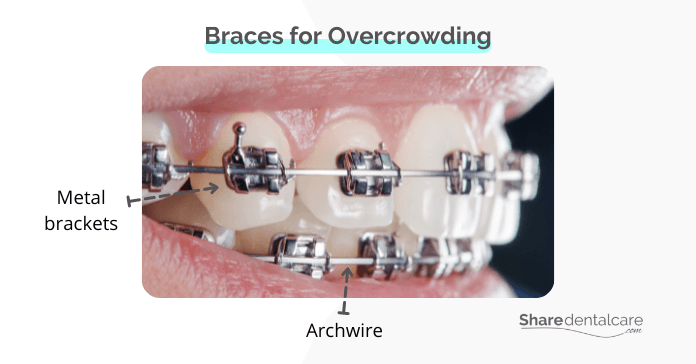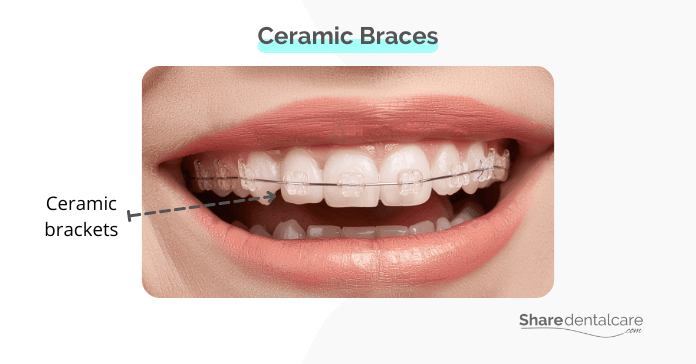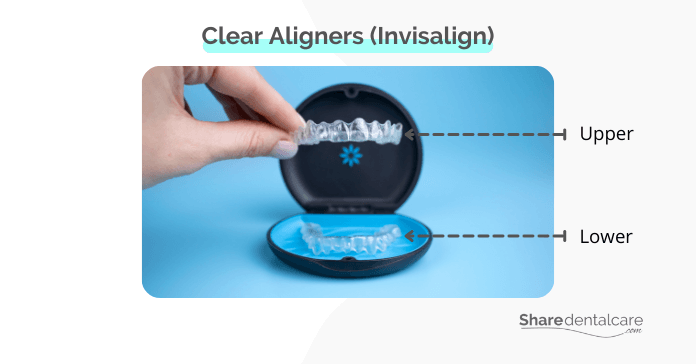Dental braces have become a popular option for treating overcrowding, an orthodontic condition that causes the teeth to overlap or be too close. They work by slowly and gently shifting the teeth into their proper position. Braces not only improve your smile but also improve your chewing and speaking and can prevent TMJ disorders. In this blog post, we will discuss types of braces for overcrowding.
What is Overcrowding?
Overcrowding occurs when there is not enough room for all of the teeth to fit in the jaw properly. This can cause teeth to overlap, twist or become crooked. Overcrowding can also cause gum disease and tooth decay because it is harder to brush and floss correctly when the teeth are overlapped. Other complications of teeth crowding include:
- Aesthetic problem: Overcrowded teeth can look unattractive and affect the appearance of your smile.
- Tooth decay and gum disease: Misaligned teeth can trap bacteria and food debris, and are difficult to clean.
- Pain: Overcrowded teeth can cause pain in the jaw, neck, and head.
- Chewing problems: Difficulty chewing properly can lead to nutritional deficiencies.
- Speech problems: Overcrowded teeth can alter the way you produce sounds when speaking, making it difficult to pronounce certain words.
- TMJ disorders: Teeth crowding can contribute to temporomandibular joint disorders (TMD).
How Can Braces Correct Overcrowding?
Dental braces are orthodontic devices used to straighten teeth and correct bite alignment issues. They work by using gentle forces over a period of time to move the teeth into their correct position. Braces are an ideal solution for overcrowding because they can help to create more space in the mouth, redistribute the teeth, and align them properly. Additionally, they can help to improve chewing efficiency, enhance your smile, improve speech, and prevent future dental problems.
Dental braces consist of brackets that are attached to each tooth and connected by a metal archwire. The brackets apply gentle pressure on the teeth over a period of time, slowly shifting them into their proper positions. This process can take anywhere between six months and two years, depending on the severity of your overcrowding. Braces can also be used to correct other orthodontic issues such as gaps between teeth and underbites.

Types of Dental Braces for Overcrowding
There are a variety of different types of braces available to treat overcrowding.
- Metal
- Ceramic
- Lingual
- Clear aligners
Traditional Metal Braces
Traditional metal braces are the most popular and effective type for overcrowding. They consist of small metal brackets attached to each tooth and connected by a metal archwire. This archwire applies gentle pressure on the teeth over a period of time, gradually shifting them into their proper positions. Traditional metal braces are more affordable than other types and are suitable for treating mild, moderate, and severe overcrowding. However, they are also more noticeable than other types due to their metal components.
Ceramic Braces for Overcrowding
Ceramic braces are similar to metal braces except that they use tooth-colored brackets instead of metal ones. This makes them less visible and more aesthetically pleasing. In addition, ceramic braces are less likely to cause irritation or discomfort because they are smoother and smaller than traditional metal braces. However, they are more expensive than metal braces.

Lingual Braces
Lingual braces are similar to traditional metal braces, except that the brackets and wires are placed on the back of the teeth instead of the front. This makes them completely invisible, making them a popular choice for adults who want to correct their overcrowding without the look of braces. However, lingual braces can be more expensive than traditional metal braces, cause more discomfort, and take longer to adjust.
Clear Aligners
Clear aligners, like Invisalign, are transparent plastic trays that fit snugly over the teeth. These trays apply gentle pressure to the teeth, gradually shifting them into the desired position. Clear aligners are less visible than traditional braces and can be removed during meals, making them a more convenient option for adults who want to correct their overcrowding. However, clear aligners are more expensive than other braces and are recommended only for treating mild to moderate cases of overcrowding. Clear aligners, like Invisalign, are not recommended for severely crowded teeth.

Aftercare Tips
Once your braces are in place, you must take extra care of your teeth and gums to ensure that the treatment is successful. Here are some tips:
- Brush your teeth twice a day with fluoride toothpaste.
- Floss every day or use an interdental brush to remove any food particles that may become lodged between your teeth.
- Visit your dentist and orthodontist regularly for check-ups and adjustments.
- Avoid eating hard or sticky foods that can damage your braces.
- Don’t chew on things like pencils or pens.
- Wear a mouthguard during sporting activities to protect your teeth and braces.
Dental braces can be a great way to correct overcrowding and prevent future dental problems. With the right care, your braces will help you achieve the perfect smile you’ve always wanted.
Braces for Overcrowding – Conclusion
Braces for overcrowding can be a great way to improve your smile and boost your confidence. Different types are available, each with its own advantages and disadvantages. Traditional metal braces are the most popular and more affordable than other types, while ceramic or clear aligners may be more aesthetically pleasing. Whatever braces you choose, it is important to follow proper aftercare instructions and visit your dentist regularly for treatment to be successful. With the right care, your braces will help you achieve a beautiful smile that you can be proud of.